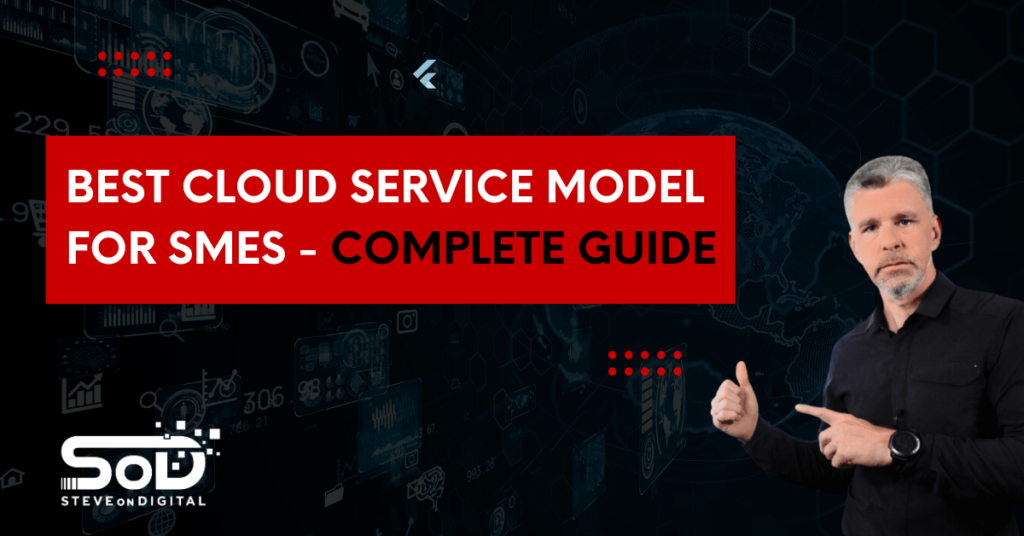Which Cloud Service Model Is Best For Small Business?

As Steve Johnston, a seasoned Digital Transformation Specialist with a robust background in electrical engineering, an MBA, and a master’s in Project Management, I have dedicated my career to empowering small and medium-sized enterprises (SMEs) through digital innovation. My goal is to guide 1,000,000 business owners and IT directors through the intricate digital landscape, offering actionable advice and insights from real-world experiences. Cloud Computing For SMEs Cloud computing has revolutionized the way businesses operate, offering a plethora of benefits that are particularly advantageous for SMEs. At its core, cloud computing provides accessibility, scalability, and cost-efficiency, three pillars that support the growth and agility of small businesses in today’s digital economy. Accessibility ensures that vital business data and applications are available anywhere, anytime, as long as there’s an internet connection. Scalability allows businesses to adjust their resources based on current needs, avoiding unnecessary expenses on infrastructure that isn’t in use. Most importantly, the cost-efficiency of cloud computing eliminates the need for substantial upfront investments in hardware and software, leveling the playing field for SMEs competing against larger corporations. Service Models Overview In the realm of cloud computing, three primary service models stand as the backbone for businesses seeking to harness the cloud: Software as a Service (SaaS), Platform as a Service (PaaS), and Infrastructure as a Service (IaaS). Each model offers a unique set of resources and services, designed to cater to different business needs and technical capabilities. SaaS delivers software solutions via the internet, eliminating the need for installations and maintenance. PaaS provides a platform allowing businesses to develop, run, and manage applications without wrestling with the complexity of building and maintaining the infrastructure typically associated with the process. Lastly, IaaS offers comprehensive control over computing resources hosted in the cloud, presenting businesses with a virtualized hardware over which they can run whatever operating systems and applications they choose. The Selection Challenge Selecting the right cloud service model is critical for SMEs to maximize the benefits of cloud computing. The decision should be informed by a clear understanding of the business’s specific needs, technical capabilities, and future growth plans. It’s not just about adopting cloud services; it’s about choosing the model that aligns perfectly with your business strategy to foster growth, innovation, and competitiveness. Understanding Cloud Services For Small Businesses Basics Of Cloud Services Cloud services fundamentally transform how small businesses access and utilize computing resources. By offering on-demand access to computing resources over the internet, cloud services eliminate the need for SMEs to invest in and manage physical servers or other infrastructure. This encompasses not just cloud storage, where data can be securely stored and accessed from anywhere, but also the broader spectrum of cloud service models like SaaS, PaaS, and IaaS. These models provide a range of services from software applications to complete computing platforms and infrastructure, all available over the web with pay-as-you-go pricing. Importance For SMEs For SMEs, the shift to cloud computing is not merely a technological upgrade; it’s a strategic transformation that can redefine the entire business landscape. This transition to cloud services can significantly reduce upfront costs associated with purchasing and maintaining IT hardware and software. Furthermore, the scalability offered by cloud computing means that SMEs can easily adjust their computing resources to match their business demands, ensuring they’re not paying for idle resources. Perhaps one of the most compelling benefits of cloud computing for SMEs is the facilitation of remote collaboration. With data and applications available online, teams can collaborate in real-time from anywhere in the world, breaking down traditional barriers to productivity and innovation. Comprehensive Exploration Of Cloud Service Models In my journey as the Digital Transformation Specialist behind SteveOnDigital, I’ve navigated through the vast expanse of cloud computing, applying its principles to help small and medium-sized enterprises (SMEs) achieve significant milestones. Here, I dive deep into the three main cloud service models, drawing from my own experiences and industry standards to shed light on which cloud service model is best for small businesses. Let’s explore the core models: Infrastructure as a Service (IaaS), Platform as a Service (PaaS), and Software as a Service (SaaS). Infrastructure as a Service (IaaS): Definition And SME Benefits IaaS offers a virtualized computing infrastructure managed over the internet. For SMEs, this model is a game-changer. It eliminates the need for hefty investments in physical hardware, providing businesses with the flexibility to rent computing resources such as servers, storage, and networking capabilities. The key benefits for SMEs lie in the unparalleled control, customization, and scalability it offers. Businesses can tailor their computing resources to meet specific needs and scale these resources up or down based on demand, ensuring cost efficiency and agility. Examples And Ideal Use Cases Prominent examples of IaaS include Microsoft Azure and Amazon Web Services (AWS). These platforms are ideally suited for businesses that require specific control over their computing environment and have the IT expertise to manage and configure their infrastructure. IaaS is perfect for companies looking to run high-performance applications, store large volumes of data, or have unique security requirements. Platform as a Service (PaaS): Definition And Ideal Use PaaS provides a framework for developers to build upon and create customized applications. This cloud service model offers a development platform and a set of tools to simplify the process of coding, testing, and deployment of applications. The beauty of PaaS lies in its pre-configured features and ease of app deployment, allowing developers to focus on the creative side of application development without worrying about the underlying infrastructure. Examples And Considerations Google App Engine and Azure App Service stand out as prime examples of PaaS. These platforms cater to businesses with some level of technical know-how and those looking to develop, run, and manage applications without the complexity of building and maintaining the infrastructure. PaaS is ideal for companies aiming to create customized applications or those that require a collaborative environment for multiple developers. Software as a Service (SaaS): Definition And Advantages For SMEs SaaS revolutionizes software usage by providing access

